Printed with permission from Dirt Sports Magazine from the 2009 March/April issue.
Most of us remember the bygone era when a transaxle upgrade simply consisted of swapping in a modified Volkswagen Bus box and calling it a day. As race vehicles, prerunners and sand cars have evolved over the years, so has the amount of horsepower propelling them. Nowadays, horsepower figures that were unheard of only a few years ago are the norm. Needless to say, the trusty 091 box would quickly be turned into scrap by the big V8s and other high-revving engines found in today’s modern off-road cars.
Just as the vehicles have evolved, so have the sport’s transaxles and gearboxes. Constant research, development and testing by companies always pushing the envelope have lead to major strides in technology and design. The results are stout products that can take a ton of power along with major punishment. What follows is a look at the latest offerings of the top companies in the business.
Albins Off-Road Gear
Albins is an Australian company founded in 1978 by Ivan Albins as a small family business. The company quickly made its mark with redesigned Volkswagen gears that were much stronger and built for competition. From there, Albins quickly took off and began developing full gearboxes and transaxles for a variety of applications. Today, Albins employs more than 50 people and made a name for itself in America via their heavy-duty racing transaxles (over 90 percent of its product is exported to the United States). Contact in the USA: Weddle Industries, 7200 Hollister Avenue, Suite C, Goleta, CA 93117; 805-562- 8600; www.weddleindustries.com.
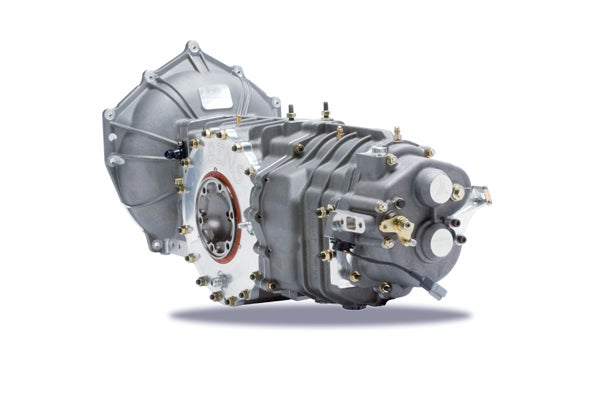
AGB/AGB Sequential: The AGB (above) is built to withstand massive horsepower and take a punishment off-road. It features a huge 11.5-inch ring gear (or crown wheel as the Aussies call it) and is constructed from a cast LM25 aluminum housing that’s heat-treated to T6 condition. The AGB is available in a five- or six-speed configuration with an “H” pattern shift. Gears are helical cut for maximum strength and are either synchromesh or dog change. Billet machined differential side plates are used for extra strength along with bronze load bolts to support the crown wheel under extreme loads. It is available for mid or rear-engine configurations and comes with 934/935 CV joint drive flanges. A planetary diff is used for increased strength and traction along with a 1 1/8-inch input shaft. A host of options are available, including drive flanges for 930 or series 30 CV joints, bell housings for Chevy LS1 or small block engines, custom engine adaptor plates, flywheels and input shafts. The AGB Sequential has the same features as the AGB but offers a five- or six-speed dog change sequential shift.
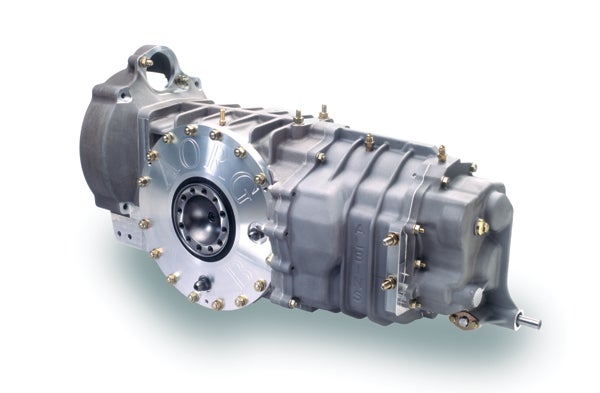
AGB 10/AGB 10 Sequential: The AGB 10 (above) and its sequential shift counterpart, the AGB 10 Sequential, utilize the same stout construction and have the exact features of the AGB. The AGB 10, however, uses a smaller 10-inch ring gear making it better suited for less horsepower-intensive applications. But given that the AGB 10 uses the same design and build components as the AGB, it’s still a very stout transaxle that can handle lots of horsepower.
AGB/AGB 10 Gen 3: The Gen 3 has identical specifications to the original AGB and AGB 10, but the shift rod is attached high on the transaxle and can be placed from either direction for flexibility. This makes the Gen 3 a much easier retrofit into racecars originally equipped with transaxles from other manufacturers such as Mendeola and Fortin.
Fortin Racing Inc.
A name synonymous with transaxles for the past 40 years is Fortin Racing. In 1971, Fortin Racing developed and converted the first Hewland DG-300 transaxles for off-road use, which were originally designed for Formula 5000 open-wheel and Indy car racing. Fortin then created its own transaxle (the Fortin 5 Speed) in the early 1980s. With almost 30 years of R&D, the 5 Speed has evolved to meet the high horsepower demands of today’s market. Fortin Racing has developed other transaxles to keep pace with consumer demand as well. Currently in a brand-new 10,000-square-foot facility, Fortin offers a full line of high-quality, reliable transaxles. Fortin Racing Inc., 9422 Bond Avenue, El Cajon, CA 92021; 619-449-3633; www.fortinracing.com
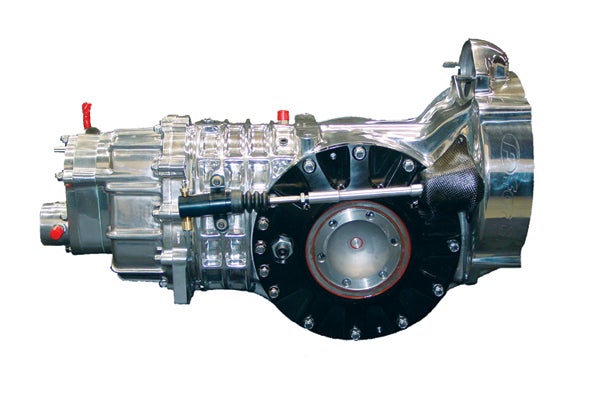
Fortin 4 Speed/FRS4: The Fortin Racing 4 Speed (above) features 25mm wide gears, along with a 10-inch ring and pinion made from heat-treated proprietary British alloys. Ring and pinion gearing is available in 4.86, 4.38 or 3.88 ratios, and the transaxle can be set up for 930 or 934/935 CV flanges. The gears are straight cut for maximum power transfer and engagement is dog ring for fast, no-clutch shifts. It can either be run mid or rear engine and comes with an internal oil pump. The 4 Speed can use a clutch or torque converter and comes with either an open, limited slip or spool differential with a differential flange width of 7 ¾ or 8 ½ inches. The FRS4 is the sequential version of the 4 Speed, and both transaxles can handle up to 700 horsepower with a converter and 525 horsepower with a clutch in a race vehicle. In recreational form, the limits are 1,000 horsepower with a converter and 850 with a clutch. The 4 Speed weighs in at 145 lbs. and is 28 inches long, with the sequential being 150 lbs. and is 29 inches long.
Fortin 5 Speed: The Fortin 5 Speed has the same features as the 4 speed but uses 18mm wide gears. It is 135 lbs., 28 inches long and can be fitted with an optional power steering pump on the end cover or a torque converter pump. With a clutch it can handle 300 horsepower in a race car and 600 in a play car. Equipped with a torque converter, limits jump to 600 horsepower for race and 750 for play.
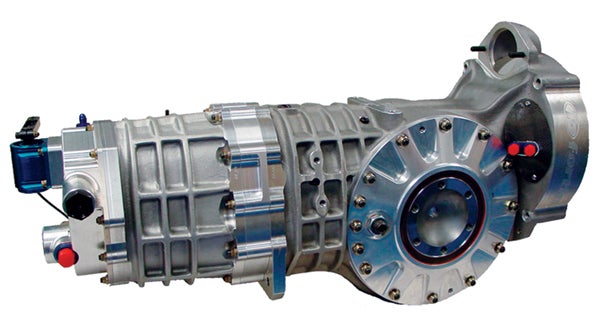
FRS5: A sequential five-speed, the FRS5 (above) is a completely different box from the standard shift 5 Speed and is the strongest Fortin box offered. While it has many of the same features of the 4 Speed listed above, it uses beefy 28mm-wide gears and weighs in at 190 lbs. At 33-inches long, the FRS5 offers an electric or manual reverse lockout. In a play car, the FRS5 can handle a staggering 1,200 horsepower with a torque converter or 950 with a clutch. Limits are slightly less in a racecar with 580 horsepower being the limit with a clutch and 750 the max with a converter.
FRS6: The FRS6 has the same features found in the 4 Speed but it uses 21mm-wide gears. It also has an electric or manual reverse lockout. Dimensionally, it’s 33 inches long and weighs in at 185 lbs. It can handle up to 800 horsepower with a torque converter and 700 ponies in a play car. For racing, the limits are 650 with a converter and 400 with a clutch.Mendeola Transaxles Inc.
Well known in desert racing circles, Mendeola has a stellar reputation for producing extremely high-quality, rugged and reliable transaxles. To ensure quality, a vast amount of manufacturing is performed in-house at its 42,000-square-foot facility, including splining, broaching, shaping, hobbing and CNC grinding. Mendeola’s transaxles have been in everything from Baja to Dakar to Road America, and the company offers a wide selection of products for all levels of vehicles. Mendeola Transaxles Inc., 1695 Cactus Road, San Diego, CA 92154; 619-710-8800, www.mendeolatransaxles.com.
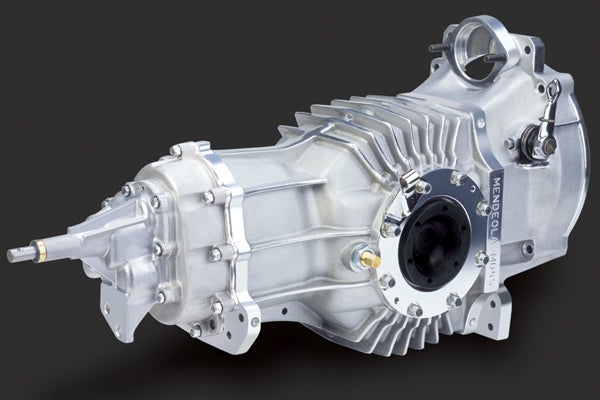
MD4E: The MD4E (above) is Mendeola’s entry-level transaxle but uses the same case as the MD4-2D. While this gives it strength, it also means that the MD4E can be upgraded whenever needed to handle more horsepower. It can handle 325 horsepower in the sand and 175 horsepower off-road with a max vehicle weight of 1,950 lbs. Adding to its strength is a Ford 9-inch spider differential and a 10-inch diameter ring gear. Weddle Racing 002 gear sets are used as well as a 300M, VW-style 24-spline input shaft to add further beef. A 5.14 ring and pinion ratio is standard with options including a 4.11 or 4.86 gear ratio, mid-engine shifter and aluminum intermediate housing.
MD4-2D: The MD4-2D is known by most simply as the 2D and is one of the most used transaxles in the sand and off-road car market. Built to withstand 375 horsepower and a max vehicle weight of 2,200 lbs., the 2D uses extra wide Weddle Racing gearsets and an A-356 T-6 aluminum casing. Further strength comes from a G50 style, 300M one-inch input shaft, along with billet slider hubs and input coupler. High capacity bearings on the pinion and main shaft are also used. The 2D comes set for 930 CV joints with either a 4.86, 5.14 or 5.42 ring and pinion. Options include 935 drive stubs, reverse rotation ring and pinions and a mid-engine shifter.
MD5: The MD5 shares all the same attributes as the MD4-2D but adds a fifth gear for those who need better fuel mileage or reduced RPM at speed. Off-road racers utilize the MD5 as well for the ability to stack third, fourth and fifth gears. In fact, this gearbox has won the SCORE-Lite Championship three times. Options include 935 drive stubs and reverse rotation gears.
S4/S5: The S4 and S5 are Mendeola’s sequential shifting gearboxes with the S4 featuring four forward speeds and the S5 offering five. Both feature 85mm shaft centers, super-duty 28mm-wide Weddle gearsets, 19mm reverse and 935 flanges. The S4 is equipped with 1.090-inch wide drive members while the S5 driving members are .800 inches wide. With its slightly smaller drive gear dimensions, the S5 handles 20 to 25 percent less torque than the S4, which is rated to handle 425 horsepower in a racecar, 500 horsepower in a pre-runner and 600 ponies in a sand car. Helping to achieve these numbers is the use of a hybrid Dana 60 differential and a 1 3/16-inch, 18-spline input shaft made from
300M. The S4/S5 are available with 4.57, 4.63 or 4.86 ultra-duty ring and pinions, along with six- or eight-lug dog rings.
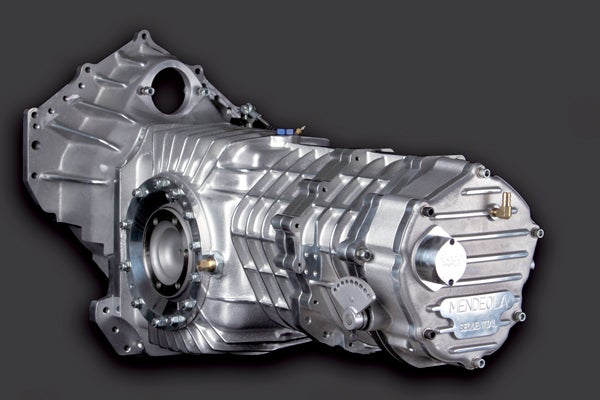
S4D: The S4D (above) is Mendeola’s heavy-duty, four-speed sequential transaxle. Built to take up to 650 horsepower, 37-inch tires and up to 4,500 lbs. of vehicle weight, the S4D is meant for serious sand buggies, heavy-duty pre-runners or Unlimited class racecars. It uses a massive 11.5-inch Forged 9310 VAR ring and pinion set, super-duty 14 Bolt Alloy differential and eight-bolt HD4 style pinion bearing housing. Billet aluminum side covers are used along with an A-356 T-6 aircraft quality aluminum case. A V8 bell housing comes standard and is set up for a proprietary Kennedy 8-inch triple disc full metallic clutch. A beefy 19mm reverse gear and 6.5-inch differential bearings make this one stout transaxle. Thanks to new gearsets that feature integrated dog rings, there is also an S5D upgrade available like the one featured in our new AlumiCraft “Plug N’ Play project.
HD4: Mendeola calls the HD4 the strongest racing transaxle on the planet and refers to it as the Transaxlesaurus. It can handle up to an amazing 1,600 horsepower on the sand and 850 horsepower in an off-road racecar. A four-speed sequential unit, it’s based on 101mm shaft centers with a massive 13-inch ring and pinion. All gears have replaceable faceplates and the massive differential features 8-inch carrier bearings. A huge
22mm reverse gear is standard and it accepts KEP triple-disc metallic 8-inch clutches. The HD4 can also be equipped with a torque converter, giving it the ability to take even more power. It is built to be a take-no-prisoners transaxle that delivers brute strength and unmatched reliability.
PBS Engineering Inc.
PBS Engineering actually has its early roots in SCCA sportscar racing in the early 1960s. Competing in a 750cc displacement limit class, PBS utilized a funky ABARTH twin-cam engine but the parts were too hard to get in the U.S. PBS decided to make its own engine and the business was born. PBS eventually began developing its own transaxle for land speed racing and IMSA programs in the late ‘80s and early ‘90s. From there, PBS became involved in desert racing and currently offers three transaxles that are built in house. PBS Engineering Inc., 11602 Anabel Street, Garden Grove, CA 92843; 714-534-6700; www.pbseng.com.
PQH-4/PQS-4: The PQH-4 transaxle is built to handle 500 to 600 horsepower while being cost-effective, strong and reliable. It is a four-speed unit with an “H” pattern that features massive one-inch-wide gears on 85mm shaft centers with replaceable dog face plates. The gears are available either straight cut from PBS or in a helical design from
Weddle Industries with the ring and pinion gears also from Weddle. Highgrade A356-T6 aluminum is used for the housing and it uses output flanges for 934/935 CV joints. There’s also a high-strength reverse gear that’s 0.7 inches thick and features an internal reverse lockout. PBS incorporates its own cable shifter into the design, allowing the PQH-4 to be either front or rear engine mounted. It’s also designed to fit all popular bell housings such as Subaru, LS1 and VW 9 inch. The PQS-4 is the sequential version of the PQH-4 that uses a sequential shift mechanism designed and manufactured by PBS with a spring return remote shift lever assembly and a separate reverse lever.

RD-4: The RD-4 transaxle (above) is designed to be the same length as a 2-D transaxle but extremely strong. It can handle up to 500 horsepower by utilizing the 85mm PQS/H-4 shaft spacing (2-D transaxles use 65mm shaft spacing) in a compact design. The same heavy-duty case as PQS/H-4 is used but with ¾-inch wide gears and a ½-wide reverse gear allowing for smaller dimensions. Using the 85mm spacing also allows the RD-4 to be equipped with 930 CV joints with a Dana 44 differential or 934/935 CV joints with the larger PBS-designed Dana 60-based differential. It’s a four-speed unit with a high-strength reverse and all gears are straight cut using dog-gear engagement with six dogs. A 1 3/16-inch, 18-spline input shaft is standard and it can be adapted to LS1, Subaru or VW applications.
Transaxle Engineering
Transaxle Engineering was started in 1978 when Jeff Fields, a longtime Volkswagen and buggy enthusiast, bought the company from a longtime friend. From there Fields grew Transaxle Engineering to include customers such as Cal Wells of PPI, along with a large contingent of off-road, Dakar and vintage racers. While expanding the company, Fields paid careful attention to quality control to ensure his customers received the best possible product. Today Transaxle Engineering is a smaller shop but its size allows it to be focused on quality with only long-term employees highly trained by Fields building transaxles. It also offers unique products such as its automatic transaxles that were completely developed in-house. Transaxle Engineering, 9763 Variel Avenue, Chatsworth, CA 91311; 818-998-2739; www.transaxleengineering.com.
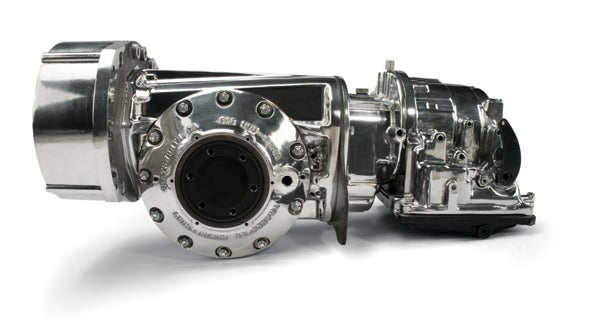
Transaxle Engineering Automatic: The Transaxle Engineering Automatic (TAE, above) is an automatic transaxle that uses a modified Audi Turbo three-speed automatic section with a full-manual valve body. A quick-change gearset allows for almost infinite gear possibilities, with final drive ratios between 2.60 and 8.80 available. Most are geared between the 5.50 and 6.50 range, allowing the big automatic to be run in second and third gear all day. In third gear, the automatic locks up the direct clutches and doesn’t work through the planetaries, dramatically improving longevity and horsepower capacity. Adding to the stoutness is the 4340 Chromoly differential with a 35-spline Dana 60 spider gearset and 7-inch carrier bearings. A Sprint car quick-change ring and pinion is also part of the package with 4.11, 4.56 and 4.86 gear ratios available. There’s a custom billet torque converter specialized to the customer’s application. The automatic can handle big horsepower (500 plus) and run for thousands of miles between service intervals.
Water Boxer Vanagon Automatic: The Vanagon automatic is another automatic transaxle built by Transaxle Engineering and is designed to handle power up to a 4.3L V6. It uses a full manual valve body along with a billet four-gear differential, shot-peened gears and a Super Duty reverse. This smaller automatic is a mid mount and comes with 930 flanges and a 4.09 final drive ratio.
Weddle Industries
Weddle Industries has been around in one form or another since the early 1970s. John Weddle, who was a firefighter in Huntington Beach, began building VW transaxles out of his garage to fund his growing off-road racing habit. The lack of quality high-performance parts available eventually spurred a dramatic change at Weddle Industries, from building transaxles to supplying parts to other transaxle builders in the industry. Weddle formed an alliance in 1993 with Albins Off-Road Gear in Australia to create heavy-duty racing gears. Today Weddle Industries has a full line of Weddle Racing Gears manufactured by Albins Off-Road Gear, made exclusively to Weddle’s proprietary specs and dimensions.
Weddle Industries is also the exclusive importer of Albins transaxles to North America. A second alliance with Mike Mendeola of Mendeola Transaxles has Weddle Industries supplying all racing gears for the majority of Mendeola’s Transaxles. Weddle Industries also supplies parts varying from high-performance to stock replacement to other outlets, including the backyard hobbyist or a custom transmission shop. Weddle Industries, 7200 Hollister Avenue, Suite C, Goleta, CA 93117; 805-562-8600; www.weddleindustries.com.
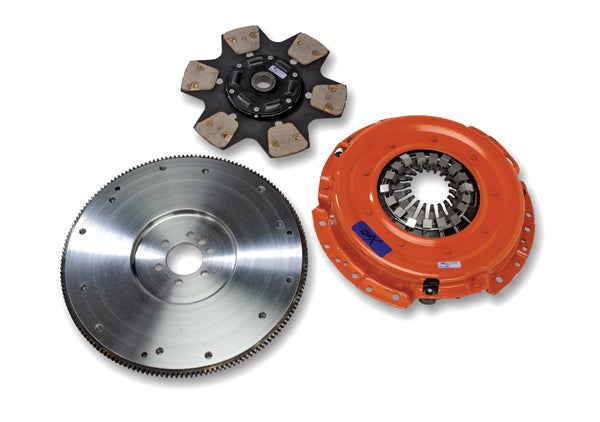
11-inch Clutch: Weddle Industries partnered with clutch specialists Centerforce to develop a line of off-road specific clutches. As a result of this partnership, Weddle offers two new SFI-approved 10.4-inch and 11-inch DFX clutch assemblies (above) for the Albins transaxle. These purpose-built pressure plate and disc sets are designed for use in conjunction with special Centerforce steel billet flywheels made for GM V8 powered off-road vehicles. All DFX performance clutch systems utilize a patented ball-bearing designed for light pedal effort and smooth, precise operation. Furthermore, nodular iron pressure plate rings and advanced reinforcements are designed to help prevent drive strap breakage and add safety. The Centerforce DFX button style disc utilizes high-friction, Cerametallic linings and a superior sprung hub disc that has been engineered to reduce driveline shock. These features, coupled with the famous Centerforce centrifugal weight system, give these clutches exceptional holding power with drivability that far surpasses any previous off-road clutch.
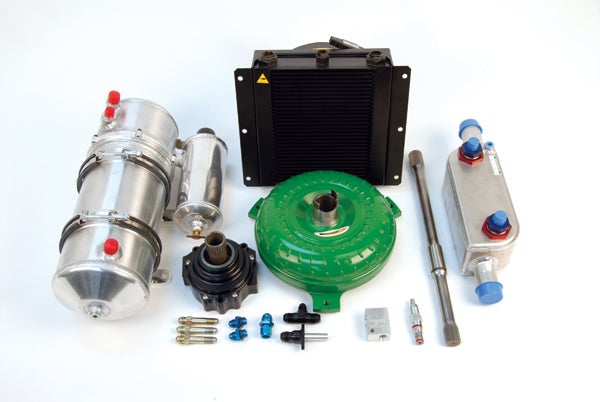
Albins Torque Converter Package: A new package from Albins Off-Road and Weddle Industries, this kit (above) is everything you need to run a torque converter with your Albins transaxle, minus the flex plate and trans spacer. Just mount it and plumb it. A flex plate and spacer are not included in the kit, as they will be different for various engines. There is also no need for a separate belt-driven oil pump for the converter because the pump is in the stator support. The system is high flow and low pressure, with the goal being to avoid the extra heat generated by high-pressure trans fluid. This package is available for all the various Albins transaxle models and can be retrofitted onto earlier transaxles (disassembly and machine work required on early models). The standard version uses the Albins Chevy bell housing, but it’s available for a VW-style bell housing for non-GM engine packages.
Xtrac Inc.
While not a household name in the U.S., Xtrac is well known in elite European motorsports circles. Established in 1984, Xtrac quickly became the gearbox manufacturer of choice in the extremely competitive Formula One and World Rally Car circuits and cross country rallies such as Dakar. Xtrac’s gearboxes have since won 26 Formula One World Championships, 20 CART Championships, 15 Indy 500 victories, 23 World Rally Championships and 14 Dakar victories. Xtrac’s massive 88,000-square-foot facility in England is built to support its host of customers. Recently, Xtrac also opened a facility in the US to support its growing contingent of Indy Racing League customers as well spearhead its off-road efforts. Xtrac USA, 6183 West 80th Street, Indianapolis, IN 46278; 317-472-2454; www.xtrac.com.
383B Class 1 Off-Road Baja Gearbox: The latest ‘383B’ builds upon what Xtrac has learned in the Dakar Rally and Baja. The 383B is a lightweight, positive sequential six-speed gear change box with class-leading dimensions, including narrow flanges (934/935 standard) and an axle centerline to motor block face distance as small as 9.3 inches along with a unique, service-friendly externally-mounted clutch assembly. Built to be a cost-effective, flexible transmission gear selection is either from the left- or right-hand side using dog clutch non-synchro engagement in a quick change ‘cassette style’ cluster with a dog-engaged reverse. The stressed aluminum L169 casing assembly has O-ring face sealing and universal bosses for chassis mounting. Unique features include a slipper unit and a three-foot long input shaft to absorb shock loads.
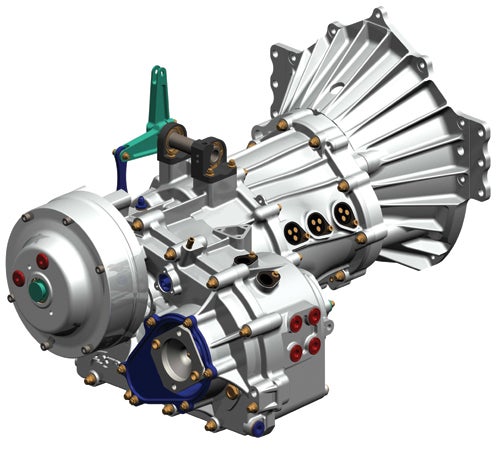
502 Trophy-Truck Transmission: Built on the same principals as the class-winning 383 transaxle, this transmission (above) employs a slipper unit and long input shaft to absorb shock loads. The transmission also has an integral step off/transfer housing, which allows it to be used in a ‘V-drive’ configuration (in addition to standard installation) and adds ratio, reducing the requirements on the highly-stressed ring and pinions in most TT applications. Standard features include a unique plunging 1410 yoke flange that permits the use of a stronger one-piece driveshaft, rear-mounted clutch assembly for ease of service, dog-ring inspection ports, twin-stage internal oil pump and oil level sight glass. Options for the transmission include an extensive choice of ratios, standard low cost bell housings to suit most motors, pneumatic semi-auto shift unit, super-polished gears and Hi/Lo gear range selector.
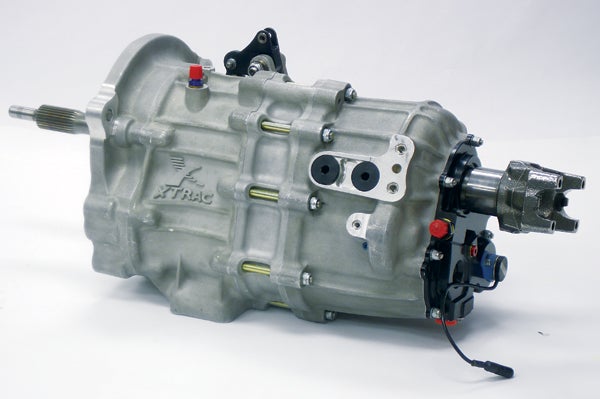
437/559 Short Course 2WD & 4WD Transmiss ions: The 437 (above) and 559 are two new transmissions developed specifically for the short-course off-road market. Built to be lightweight and strong, the 437 and 559 are designed to be alternatives to conventional three-speed automatics. Both units are six-speed sequential shifts using dog clutch non-synchro engagement. ‘Quick Change’ type input drop gears permit changes in overall ratio while extensive stock of change gears gives large ratio choices. Standard bell housings to suit Dodge, Ford, Chevrolet and Toyota motors are able to house a clutch or optional torque converter package. The ‘437’ 2WD unit has a 1350 yoke output, while the ‘559’ 4WD version provides a rear bolt pattern which allows direct attachment of existing transfer cases and/or under-drive units. Aluminium casings and their small size keep the weights down to 90 lbs. and 95 lbs., including bell housing for the 2WD and 4WD respectively.


 Your Privacy Choices
Your Privacy Choices